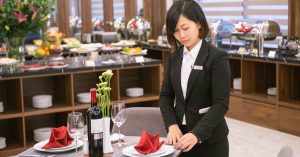When it comes to working in a fast-paced restaurant environment, safety should always be a top priority. One essential piece of safety equipment that often goes overlooked is non-slip shoes. These specialized shoes are designed to provide maximum traction and stability, helping to prevent slips, trips, and falls in the workplace. In this article, we will explore the importance of non-slip shoes for restaurant workers and highlight the key features to consider when choosing the right pair.
In the hectic and demanding world of a restaurant, spills, greasy floors, and wet surfaces are a common occurrence. This creates a hazardous environment where employees are at a higher risk of accidents and injuries. Non-slip shoes, also known as slip-resistant shoes, are specifically engineered to tackle these challenges. By offering superior grip and traction, they minimize the chances of slips and falls, ensuring the safety and well-being of restaurant staff.
When it comes to selecting the perfect non-slip shoes for the restaurant industry, there are several factors to consider. From the type of sole to the material used, each component plays a crucial role in determining the shoe’s effectiveness. By understanding these key features and knowing what to look for, restaurant workers can make an informed decision and invest in the right pair of non-slip shoes that will keep them safe and secure throughout their shifts.
Importance of Non-Slip Shoes for Restaurant Workers
Non-slip shoes play a crucial role in ensuring the safety and well-being of restaurant workers. In a fast-paced restaurant environment, where spills, greasy floors, and wet surfaces are common, the risk of slips, trips, and falls is significantly higher. That’s where non-slip shoes come in, providing the necessary grip and traction to prevent accidents and injuries.
Enhanced Safety
The primary benefit of non-slip shoes is their superior grip. Their specially designed outsoles use advanced traction technology to provide a firm footing on slippery surfaces. With each step, restaurant workers can feel confident and secure, knowing that they have the necessary support to navigate through potentially hazardous areas.
Reduced Risk of Accidents
By wearing non-slip shoes, restaurant workers greatly reduce the risk of accidents in the workplace. Slips, trips, and falls are some of the most common causes of injuries among employees, often leading to fractures, sprains, and other serious conditions. Non-slip shoes act as a preventive measure, helping to create a safer working environment for all staff members.
Increased Productivity
When employees feel safe and secure in their workplace, their overall productivity improves. By investing in non-slip shoes, restaurant owners and managers demonstrate their commitment to the safety and well-being of their staff. This, in turn, boosts employee morale and encourages more focused and efficient work.
Compliance with Regulations
In many jurisdictions, non-slip shoes are a mandatory requirement for employees working in industries with a high risk of slips and falls. By providing non-slip shoes, restaurant owners ensure compliance with these regulations and avoid potential penalties.
Enhanced Reputation
Lastly, investing in non-slip shoes for restaurant workers can also contribute to an establishment’s reputation. Customers appreciate knowing that the establishment prioritizes the safety of its employees. This can lead to positive word-of-mouth and customer loyalty, further benefiting the business in the long run.
Non-slip shoes are an essential and indispensable part of the uniform for restaurant workers. By providing enhanced safety, reducing the risk of accidents, increasing productivity, ensuring regulatory compliance, and enhancing the overall reputation of the establishment, non-slip shoes are a wise investment that promotes the well-being of both employees and the business itself.
Common Hazards in Restaurants
When it comes to working in a restaurant environment, employees face numerous hazards on a daily basis. From the bustling kitchen to the busy dining areas, these hazards can pose a serious risk to the safety and well-being of the staff. Understanding and identifying these common hazards is crucial in order to implement effective safety measures, such as wearing non-slip shoes.
Here are some of the most common hazards that restaurant workers encounter:
- Slippery Floors: Spills and wet surfaces are a frequent occurrence in restaurants, especially in busy kitchens and dining areas. Without proper footwear, employees are at a higher risk of slipping and falling, potentially causing injuries ranging from minor bruises to more severe fractures and head injuries.
- Grease and Oils: Restaurants often involve the use of oils and greasy substances in cooking. These oils can easily spill onto the floor, making it even more slippery. Without adequate grip and traction, employees navigating through greasy floors are more likely to lose their footing and experience accidents.
- Sharp Objects: In a kitchen environment, sharp objects such as knives, slicers, and other utensils are used extensively. Accidental cuts and lacerations are common when working with these tools. Slip-resistant shoes can provide stability and reduce the risk of losing balance while handling sharp utensils.
- Heavy Equipment: Restaurants often have heavy equipment, such as ovens, deep fryers, and dishwashing machines. Operating these machines requires strength and stability. Slip-resistant shoes not only provide employees with better traction but also help in maintaining a firm grip on the floor while handling heavy equipment, reducing the risk of accidents and injuries.
- Hot Surfaces: Heat is an essential element in restaurant kitchens, where stoves, grills, and ovens are constantly in use. Accidental contact with hot surfaces can lead to burns and other injuries. Slip-resistant shoes can offer protection by reducing the chances of slipping and coming into contact with scalding surfaces.
By recognizing these common hazards, restaurant owners and managers can take proactive steps to mitigate the risks and ensure the safety of their employees. Investing in non-slip shoes is a crucial measure that not only prevents accidents and injuries but also promotes a positive work environment. Rather than worrying about their footing, employees can focus on providing excellent service, resulting in increased productivity and customer satisfaction.
Without a conclusion paragraph or sentence.
Benefits of Non-Slip Shoes
Non-slip shoes offer various benefits for restaurant workers. These specialized footwear are designed to provide the necessary stability and grip to prevent slips, trips, and falls in the fast-paced and often slippery environment of a restaurant. Here are some of the key advantages of wearing non-slip shoes:
1. Enhanced Safety
Safety is the paramount concern in any workplace, and restaurants are no exception. Slips, trips, and falls are some of the leading causes of workplace injuries, and these incidents can be particularly common in restaurants due to the presence of greasy floors and spilled liquids. Wearing non-slip shoes significantly reduces the risk of accidents by providing better traction and stability, allowing restaurant workers to move around with confidence and minimize the chances of falls.
2. Increased Productivity
When employees feel safe and confident in their footwear, they can focus more on their tasks without constantly worrying about slipping or falling. Non-slip shoes enable restaurant workers to move quickly and efficiently around the restaurant, improving their overall productivity. By minimizing the time spent on injuries and accidents, non-slip shoes can help maintain a smooth workflow and keep operations running seamlessly.
3. Enhanced Comfort
Working in a restaurant often involves long hours of standing and walking on hard surfaces. Non-slip shoes are specifically designed with features that prioritize comfort. They provide cushioning and support for the feet, reducing the strain and fatigue that can result from prolonged standing. With enhanced comfort, restaurant workers can stay on their feet for longer periods without experiencing discomfort, which can positively impact their performance and well-being.
4. Improved Employee Morale
Investing in the safety and well-being of employees can have a significant impact on morale and job satisfaction. Providing non-slip shoes demonstrates that the employer values their employees’ safety and is willing to invest in measures to protect them. This can create a positive work environment, leading to increased job satisfaction, motivation, and loyalty among restaurant staff.
5. Customer Satisfaction
The safety and professionalism of restaurant workers directly impact the overall customer experience. When customers see that restaurant employees are wearing non-slip shoes, it sends a message that the establishment prioritizes safety. This can enhance customer confidence and satisfaction, as they feel assured that the staff takes necessary precautions to provide a safe and enjoyable dining experience.
Key Features to Consider when Choosing Non-Slip Shoes
When it comes to selecting non-slip shoes for work in a restaurant environment, there are several key features that should be taken into consideration. These features can ensure the maximum safety and comfort of the employees, allowing them to focus on their tasks without worrying about accidents. Below are some important factors to look for when choosing non-slip shoes:
1. Slip-Resistant Outsole: The most critical feature of non-slip shoes is their slip-resistant outsole. This is typically made from rubber or another high-traction material that provides excellent grip on wet or oily surfaces. Look for shoes that have a patterned tread design and are certified as slip-resistant by recognized testing organizations.
2. Waterproof Construction: Restaurant workers are often exposed to liquids, spills, and other wet conditions. Therefore, it’s important to choose non-slip shoes that have a waterproof or water-resistant construction to keep the feet dry and prevent discomfort.
3. Cushioned Insole: Standing for extended periods can take a toll on the feet. Look for non-slip shoes that have a cushioned insole to provide shock absorption and enhance comfort. This feature can help reduce fatigue and improve overall foot health.
4. Arch Support: Restaurant workers spend long hours on their feet, which can put strain on the arches. Choosing non-slip shoes with proper arch support can help alleviate discomfort and prevent foot problems such as plantar fasciitis.
5. Breathable Materials: Restaurants can get hot and humid, so it’s beneficial to look for non-slip shoes that are made from breathable materials. This allows air circulation, preventing excessive sweating and reducing the risk of foot odor.
6. Secure Fit: A proper fit is essential for comfort and safety. Look for non-slip shoes that have adjustable features such as laces or straps to ensure a secure fit. Shoes that are too loose or too tight can increase the risk of slips and falls.
7. Durability: Restaurant work can be demanding, so it’s important to choose non-slip shoes that are durable and can withstand the rigors of the job. Look for shoes made from durable materials that won’t easily wear out or lose their slip-resistant properties.
Types of Soles for Non-Slip Shoes
When it comes to choosing non-slip shoes for restaurant workers, one of the key features to consider is the type of sole that these shoes have. The sole plays a crucial role in providing traction and preventing slips and falls, especially in slippery environments. Here are some common types of soles that are often found in non-slip shoes:
- Rubber Soles: Rubber soles are a popular choice for non-slip shoes due to their excellent grip and traction. They are flexible, durable, and provide good slip resistance on wet and oily surfaces. In addition, rubber soles are often designed with specialized patterns or treads that further enhance their slip resistance capabilities.
- Treaded Soles: Treaded soles have deep grooves or patterns on their surface, resembling the treads found on car tires. These grooves help to channel water, oil, and other liquids away from the sole, allowing for better traction. Treaded soles are especially beneficial in environments where spills are common, such as kitchens and dining areas.
- Siped Soles: Siped soles have thin, slits or grooves cut into the surface of the sole. These slits help to increase the surface area of the sole in contact with the ground, thereby improving traction. Siped soles are particularly effective at providing slip resistance on wet surfaces, making them a suitable choice for restaurant workers who frequently encounter wet floors.
- Grip Enhancing Soles: Some non-slip shoes come with special features or technology that enhance the grip of the sole even further. This may include the addition of materials like silica, which increases the friction between the sole and the ground. These grip-enhancing soles are designed specifically to provide maximum slip resistance, ensuring the safety of restaurant workers.
When selecting non-slip shoes for restaurant employees, it is important to choose a sole that is appropriate for the specific work environment. For example, a restaurant with a particularly oily floor may require shoes with rubber or treaded soles, whereas a restaurant with a high likelihood of wet floors may benefit from siped soles. By considering the type of sole and its slip resistance properties, employers can ensure that their staff have the necessary footwear to work safely and comfortably.
Material and Design Considerations
When it comes to choosing non-slip shoes for restaurant workers, material and design considerations play a crucial role in ensuring their effectiveness in providing slip resistance.
Rubber Soles
Rubber soles are a popular choice for non-slip shoes due to their excellent traction properties. They offer a good grip on various surfaces, including wet and oily floors. The soft and flexible nature of rubber allows for better shock absorption, helping to reduce fatigue and discomfort during long hours of work.
Treaded Soles
Treaded soles feature multiple grooves or patterns carved into the sole’s surface. These deep indentations help channel away liquid and debris, enhancing traction and preventing slips. They are especially effective in environments with frequent exposure to water or other liquids.
Siped Soles
Siped soles are specially designed with thin grooves or channels, known as sipes, cut into the sole’s surface. These sipes increase flexibility and contact with the ground, improving grip on slippery surfaces. They are particularly beneficial for restaurant workers who encounter spills or wet areas regularly.
Grip-Enhancing Soles
Some non-slip shoes utilize advanced technologies to enhance grip and traction. These shoes may incorporate features such as micro-grooves, high-friction materials, or specialized gripping patterns on the sole. These innovative designs provide superior slip resistance, even in challenging environments.
When considering the material and design of non-slip shoes for restaurant workers, it’s essential to take into account the specific work environment and job requirements. Understanding the nature of potential hazards, such as wet or slippery floors, will help in selecting the most appropriate sole material and design.
By choosing the right material and design for non-slip shoes, restaurant workers can greatly reduce the risk of workplace accidents and injuries. Prioritizing slip resistance not only promotes a safe working environment but also enhances overall comfort and productivity for employees.
Conclusion
When it comes to ensuring the safety and comfort of restaurant workers, choosing the right non-slip shoes is of utmost importance. This article has highlighted the key factors to consider when selecting these shoes, including material and design considerations.
Rubber soles, treaded soles, siped soles, and grip-enhancing soles have all been discussed as effective options for enhancing slip resistance and traction. It is crucial to choose a sole that is suitable for the specific work environment to minimize the risk of accidents and injuries.
By investing in high-quality non-slip shoes, restaurant workers can significantly reduce the likelihood of workplace incidents, promoting a safe working environment. Additionally, these shoes offer enhanced comfort and productivity, allowing employees to focus on their tasks without worrying about slipping or discomfort.
By prioritizing slip resistance and traction in their footwear choices, restaurant workers can ensure their safety, comfort, and overall well-being in the workplace.
Frequently Asked Questions
Q: Why is slip resistance important in restaurant shoes?
A: Slip resistance is important in restaurant shoes to prevent accidents and injuries caused by slips and falls. Non-slip shoes with the right sole material and tread design provide better traction, reducing the risk of employees losing their footing on slippery surfaces.
Q: What are the benefits of rubber soles in non-slip shoes?
A: Rubber soles offer excellent slip resistance due to their natural grip properties. They provide better traction on wet or oily surfaces, enhancing stability and preventing slips. Additionally, rubber soles are durable and flexible, offering long-lasting comfort and protection.
Q: What are treaded soles in non-slip shoes, and why are they beneficial?
A: Treaded soles have specially designed patterns or grooves that improve the shoe’s grip on the floor. These patterns help to channel liquid away from the sole and increase the contact surface area, maximizing slip resistance. Treaded soles provide enhanced stability and are especially useful in workplaces where spills are common.
Q: What are siped soles, and what advantages do they offer?
A: Siped soles have thin grooves or channels cut into the sole’s surface. These grooves allow the shoe’s sole to flex and conform to the floor, improving grip. Siped soles are particularly effective in wet conditions as they displace water and reduce hydroplaning, enhancing slip resistance and preventing accidents.
Q: How do grip-enhancing soles improve slip resistance?
A: Grip-enhancing soles incorporate innovative technologies, such as added texture or rubber compounds with high friction properties, to provide superior traction. These soles are designed to maximize grip on slippery surfaces, making them ideal for restaurant workers who face challenging and slippery working conditions.
Q: Why is it important to select the right sole for a specific work environment?
A: Selecting the right sole for a specific work environment is crucial to ensure optimal slip resistance and safety. Different work environments have varying surfaces and conditions that require specific sole materials and tread designs. By choosing the right sole, employees can minimize the risk of slips and falls, protecting their well-being and improving productivity.
Q: How can choosing the right non-slip shoes promote a safe working environment?
A: By selecting the right non-slip shoes, employers can provide their workers with better protection against slips and falls. This promotes a safe working environment by reducing the risk of accidents and injuries. When employees feel safe and confident in their footwear, they can focus on their tasks, improving overall productivity and job satisfaction.




